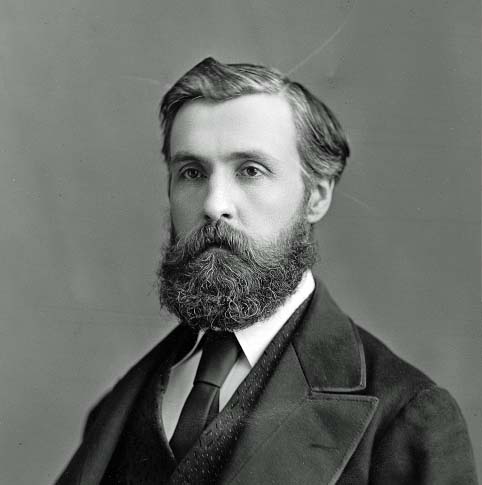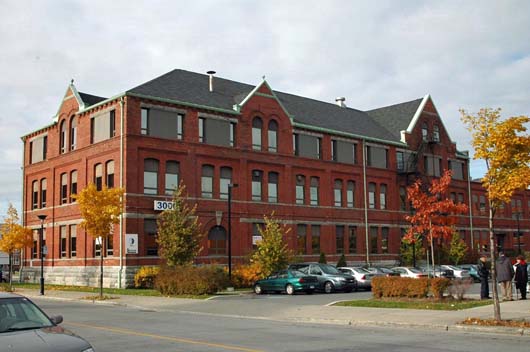CANADIAN PACIFIC RAILWAY
ANGUS SHOPS
by Andrew Merrilees

R.B. Angus - 1874 William Notman - McCord Museum II-11918.
 Introduction The Canadian Pacific Railway's Angus Shops were named after Richard Bladworth Angus (1831-1922). He was a Scottish-Canadian financier, banker,
and philanthropist. He was a co-founder and vice-president of the Canadian Pacific Railway, President of the Bank of Montreal, President of the
Royal Victoria Hospital, President of the Montreal Art Association, and co-founder and President of the Mount Royal Club. He was the natural
successor to Lord Mount Stephen as President of the CPR in 1888, but did not desire the position. Also, he twice refused a knighthood.

The Angus Shops
General Office and Administration Building - 29 Oct 2009 Marc G. Vallieres.
 The Angus Shops This tremendous locomotive, car building, and repair facility situated east of Iberville Street in the east end of Montreal, was
opened in 1904. It was designed as the main shops of the Canadian Pacific, which is a system of over 19,000 miles. The shops have fulfilled this
function admirably in the years since.
At, or around the time of its opening, the company's passenger car shop at Hochelaga, and its freight car shop at Perth, Ontario, and their
facilities were closed.
Heavy new construction programs of every kind were instituted immediately, and the number of cars of all types built at these shops between
1904 and 1920 was phenomenal. Production rivalled in every way that of a large custom car building plant, which was, in fact, what Angus had been
equipped to be.
For many years the CPR used the car building facilities of Angus to their maximum capacity, and the only cars which were built for the CPR by
outside builders during this period were those which, for various reasons, the company had not time to build themselves.
So great was the trend on the part of the CPR that in 1919 representations were made to the company by some of the custom car and locomotive
builders. Their large investments in plant were, it was claimed, unwarranted, unless at least some share of car and locomotive building work was
sent their way by Canadian Pacific, which then formed about half of the total market in Canada for this type of equipment.
The company acceded to their request, and thereafter placed most of the new car building work in the hands of custom builders. In the case of
passenger equipment however, they let the custom builders complete the frames and trucks of the car, which were then shipped to Angus for
finishing. This practice continued until 1931, after which in most cases, the custom builders finished the cars completely.
Some unusually handsome passenger cars have been built at Angus, both in wood, and in steel. In 1909 Angus shops completed eleven Mount class
observation sleepers, the first observation cars on the Canadian Pacific. These were placed on transcontinental trains and enjoyed a wide
popularity.
Also of particular interest were the first and second cars Killarney, official cars for the company's president, Sir Thomas Shaughnessy. These
were built in 1906 and 1910 respectively.
The first experimental steel passenger car was first-class coach number 999, completed at Angus in 1912. The last wooden passenger cars were
built the next year, in 1913, and in 1914 Angus launched into a steel coach production program which was only interrupted for two years during
World War I while a large portion of the plant was engaged in shell production. It resumed again at the end of the conflict, but was shortly
afterward transferred to custom car builders for the reasons previously stated.
Fifteen unusually fine official cars were built at Angus shops between the years 1926 and 1930. These beautiful heavyweight business cars are
all still running, and are maintained in top condition. They represent the last passenger train car construction built complete at Angus.
As time progressed the shops were as busy as ever, though on car repairs, rather than on new car construction. These they carried out for all
the eastern lines of Canadian Pacific's system until the shops were decommissioned in 1992.
The land covered by Angus Shop was acquired by the city of Montreal which then began redevelopment. Redevelopment consisted of several phases
including demolition of the buildings and decontamination of the soil between 1993 and 2000 at a cost of nearly $500 million.
Over its history Angus shops has built 1,866 passenger cars and innumerable freight cars. Angus was probably the largest railway shop in
Canada.
This description of Angus Shops was taken from "The Railway Rolling Stock Industry in Canada - A History of 110 Years
of Canadian Railway Car Building" by Andrew Merrilees.

|